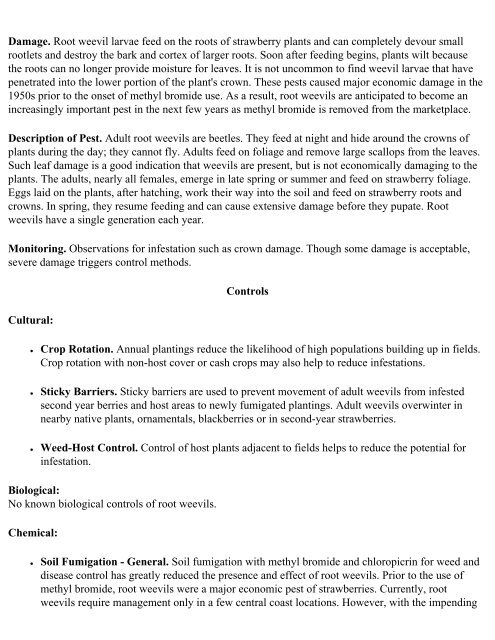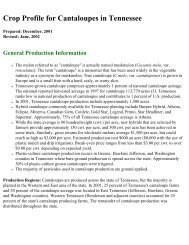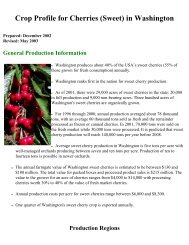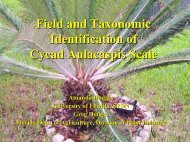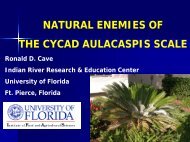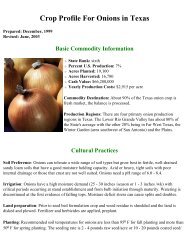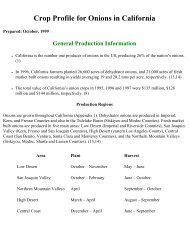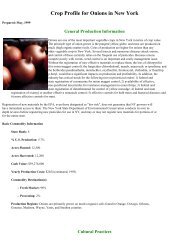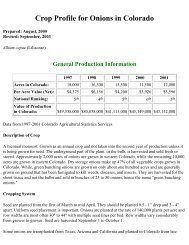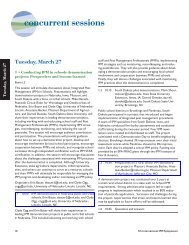Crop Profile for Strawberries in California - Regional IPM Centers
Crop Profile for Strawberries in California - Regional IPM Centers
Crop Profile for Strawberries in California - Regional IPM Centers
Create successful ePaper yourself
Turn your PDF publications into a flip-book with our unique Google optimized e-Paper software.
Damage. Root weevil larvae feed on the roots of strawberry plants and can completely devour small<br />
rootlets and destroy the bark and cortex of larger roots. Soon after feed<strong>in</strong>g beg<strong>in</strong>s, plants wilt because<br />
the roots can no longer provide moisture <strong>for</strong> leaves. It is not uncommon to f<strong>in</strong>d weevil larvae that have<br />
penetrated <strong>in</strong>to the lower portion of the plant's crown. These pests caused major economic damage <strong>in</strong> the<br />
1950s prior to the onset of methyl bromide use. As a result, root weevils are anticipated to become an<br />
<strong>in</strong>creas<strong>in</strong>gly important pest <strong>in</strong> the next few years as methyl bromide is removed from the marketplace.<br />
Description of Pest. Adult root weevils are beetles. They feed at night and hide around the crowns of<br />
plants dur<strong>in</strong>g the day; they cannot fly. Adults feed on foliage and remove large scallops from the leaves.<br />
Such leaf damage is a good <strong>in</strong>dication that weevils are present, but is not economically damag<strong>in</strong>g to the<br />
plants. The adults, nearly all females, emerge <strong>in</strong> late spr<strong>in</strong>g or summer and feed on strawberry foliage.<br />
Eggs laid on the plants, after hatch<strong>in</strong>g, work their way <strong>in</strong>to the soil and feed on strawberry roots and<br />
crowns. In spr<strong>in</strong>g, they resume feed<strong>in</strong>g and can cause extensive damage be<strong>for</strong>e they pupate. Root<br />
weevils have a s<strong>in</strong>gle generation each year.<br />
Monitor<strong>in</strong>g. Observations <strong>for</strong> <strong>in</strong>festation such as crown damage. Though some damage is acceptable,<br />
severe damage triggers control methods.<br />
Cultural:<br />
Controls<br />
● <strong>Crop</strong> Rotation. Annual plant<strong>in</strong>gs reduce the likelihood of high populations build<strong>in</strong>g up <strong>in</strong> fields.<br />
<strong>Crop</strong> rotation with non-host cover or cash crops may also help to reduce <strong>in</strong>festations.<br />
● Sticky Barriers. Sticky barriers are used to prevent movement of adult weevils from <strong>in</strong>fested<br />
second year berries and host areas to newly fumigated plant<strong>in</strong>gs. Adult weevils overw<strong>in</strong>ter <strong>in</strong><br />
nearby native plants, ornamentals, blackberries or <strong>in</strong> second-year strawberries.<br />
● Weed-Host Control. Control of host plants adjacent to fields helps to reduce the potential <strong>for</strong><br />
<strong>in</strong>festation.<br />
Biological:<br />
No known biological controls of root weevils.<br />
Chemical:<br />
● Soil Fumigation - General. Soil fumigation with methyl bromide and chloropicr<strong>in</strong> <strong>for</strong> weed and<br />
disease control has greatly reduced the presence and effect of root weevils. Prior to the use of<br />
methyl bromide, root weevils were a major economic pest of strawberries. Currently, root<br />
weevils require management only <strong>in</strong> a few central coast locations. However, with the impend<strong>in</strong>g


